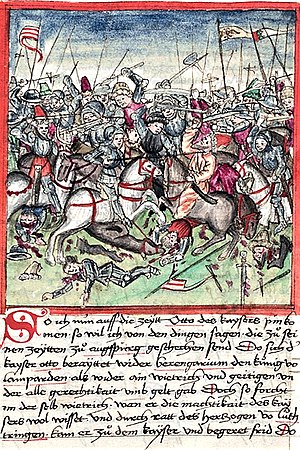Battle of the Lechfeld
| The Second Battle of Lechfeld | |||||||
|---|---|---|---|---|---|---|---|
| Part of the Hungarian invasions of Europe | |||||||
 |
|||||||
|
|||||||
| Belligerents | |||||||
|
Saxons and Thuringians Bavarians Swabians Franks Bohemians |
Magyars | ||||||
| Commanders and leaders | |||||||
|
Otto I the Great Conrad the Red (Franks) † Burchard (Swabians) |
harka Bulcsú † chieftains Lél and Súr † |
||||||
| Strength | |||||||
| 8,000 heavy cavalry and infantry | 17,000 light cavalry unknown infantry |
||||||
| Casualties and losses | |||||||
| ~3,000 | 4,000–5,000 killed: 1,000 fell in the battle ~1,500 killed by local farmers 2,000 fleeing Hungarians killed by German reserve-troops |
||||||
The Battle of Lechfeld (10 August 955) was a decisive victory for Otto I the Great, King of East Francia, over the Hungarian harka Bulcsú and the chieftains Lél (Lehel) and Súr. It is often seen as the defining event in the repulsion of the Hungarians' incursions into Western Europe. Located south of Augsburg, the Lechfeld is the flood plain that lies along the Lech River. The battle appears as the second Battle of Augsburg in Hungarian historiography. It was followed by the Battle of Recknitz in October. It was important in rallying the East Frankish realm against a foreign enemy.
The first Battle of Lechfeld happened in the same area forty-five years earlier.
Perhaps the most important source is Gerhard's monograph Vita Sancti Uodalrici, which describes the series of actions from the German point of view. Another source is the chronicler Widukind of Corvey, who provides some important details. The chronicle Gesta Hungarorum provides insight from the Hungarian side; however, this chronicle was only written in the 12th century.
After having put down a rebellion by his son, Liudolf, Duke of Swabia and son-in-law, Conrad, Duke of Lorraine, Otto I the Great, King of East Francia, set out to Saxony, his duchy. Upon arriving in Magdeburg he received reports of the Hungarian invasion. The Hungarians had already invaded once before during the course of the rebellion. This occurred immediately after he had put down a revolt in Franconia. Because of unrest among the Polabian Slavs on the lower Elbe, Otto had to leave most of his Saxons at home. In addition, Saxony was distant from Augsburg and its environs, and considerable time would have elapsed waiting for their arrival. The battle took place six weeks after the first report of an invasion, and historian Hans Delbrück asserts that they could not have possibly made the march in time.
...
Wikipedia
